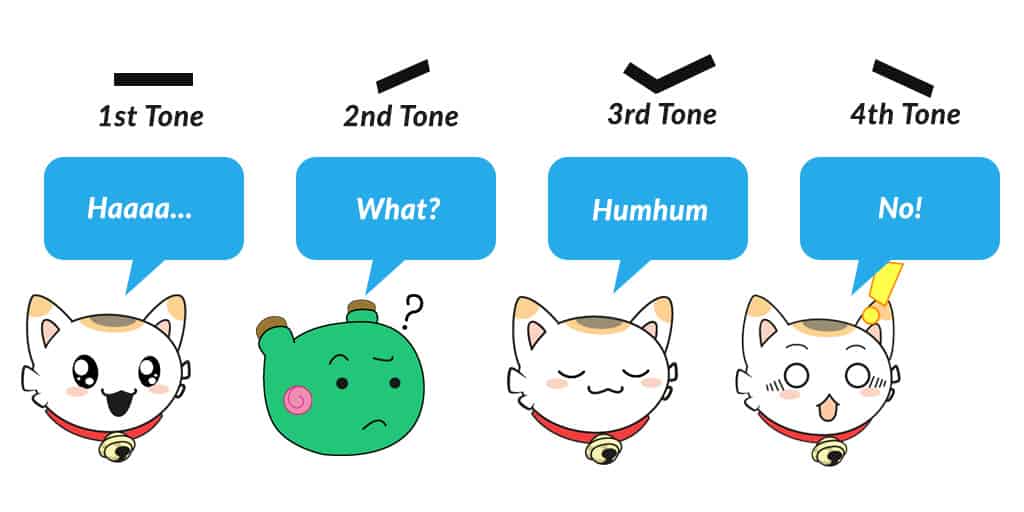An easy way to memorize and pronounce tones! The first time you hear a Chinese speaking a sentence, were you like “wow, I understand nothing and why do they sound like they’re going on a rollercoaster”? No wonder, you’re hearing tones for the first time! They may seem daunting, but I have a secret to tell you. There’s a super easy tone trick to know: you’re actually already using tones in English, so all you need to do is apply that knowledge to your Chinese! Read on so I can explain more.
One of the first things you learn about the Chinese language is that it’s a very melodic language. That’s because the Chinese language is a tonal language. A tone is a way to pronounce a syllable with intonation. Yeah, I know. It’s much easier to write it than to say it.
Tone trick: first, let’s go through a real quick reminder of what tones are.
There are four tones in Chinese, and we often say there is also a 5th tone, which is silent. Each tone should be used every time it’s needed to be understood. Even Chinese speakers on TV have courses about pronouncing the tones right. Just for you to see how important it is.
But don’t worry, it’s ok to make mistakes sometimes. Even the Chinese make tone mistakes from time to time. Doesn’t that put the pressure off a little? Having most of your tones right and a few off will be excused and you’ll still be understood if you’re speaking with someone that understands the context. Context over tones, but tones still matter.
Let’s see all 4 tones, because that’s the key to this tone trick. Understanding the tones and how they work.
- The first tone is a flat tone. You just stay on the same tune a little bit longer.
- The second tone is a rising tone. You just tune up the syllable.
- The third tone is a waving tone. Really funny to do, you go down and up when you’re saying that tone on its own, and a little down and mostly up, when it’s in a sentence. (note: the third note behaves differently when combined with other tones, but let’s explore that later on)
- The fourth tone is a drop tone. Like his name tells you, your tune goes down.
Are you starting to understand where I’m taking you with that? The secret about tones is that we already use these 4 tones in our language! When? When we want to put an emphasis on a word.
Isn’t that a meowsome tone trick to realize? Tones in Chinese aren’t so foreign after all.
🏮 Ninchanese is an incredible app for learning Chinese! 🏮
” I actually graduated from the University of Edinburgh with a MA in Chinese.
I’ve used Ninchanese daily, and it has helped me a lot! “
– Connor, Ninchanese User
Try Ninchanese, an award-winning method to learn Chinese today:
Start Learning Now
Wait, I’ll show you with examples:
- The first tone, a flat tone is actually the same intonation you use when you agree with something. Or when you say ahhhh, when you’re realized something and so you keep the same intonation for a little while.
- Second tone, rising tone. I’m sure you can imagine already: it’s like asking the question what?
- Third tone, waving tone. Easy, you know when you want the other to continue speaking and you’re like humhum? The same.
- Fourth tone, the drop. It’s like when you’re on the verge of winning a Ninchallenge, one more card to go… and your opponent just got a 6 points card correct. And you’re like. No! Oh No! Sharp no. 🙂
Here’s the tone trick with our cute Nincha and Lupishu as stars.

Okay, now, you’re all set to start speaking Chinese with the right tones. Just imitate how you speak in a certain situation to get you started. It’s a lot less daunting that way!
It’s a good way to start. Granted, it won’t feel natural until after a few tries but your tones will be alright!
Okay, now that you know this meowsome tone trick, you’re all set. Now, you can train your tones on the Ninchanese app. Start a new speaking stage, you’ll have to say words and sentence with the right tones! It’s a great tool to train yourself to use the right tones and pronounce Chinese perfectly.
Did this secret method help you? What’s your favorite way to practice saying tones? Let us know in the comments!
The Nincha Team
Stay in touch with us on Facebook, Twitter, Instagram, and Pinterest.





